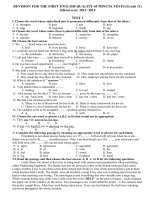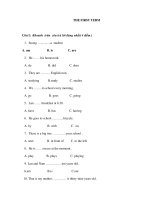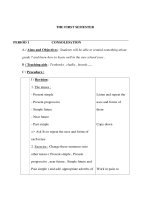The first big game
Bạn đang xem bản rút gọn của tài liệu. Xem và tải ngay bản đầy đủ của tài liệu tại đây (2.11 MB, 10 trang )
Suggested levels for Guided Reading, DRA,™
Lexile,® and Reading Recovery™ are provided
in the Pearson Scott Foresman Leveling Guide.
The First
Big Game
by Kim Borland
illustrated by Sheila Bailey
Genre
Historical
fiction
Comprehension
Skills and Strategy
• Realism and Fantasy
• Cause and Effect
• Prior Knowledge
Scott Foresman Reading Street 2.2.2
ISBN 0-328-13252-7
ì<(sk$m)=bdcfc < +^-Ä-U-Ä-U
Vocabulary
compete
contribute
recreation
Word count: 821
Think and Share
Read Together
The First
Big Game
1. Is The First Big Game a realistic story or a
fantasy? What clues in the story help you to
know?
2. What did you already know about baseball
before reading The First Big Game? What
did you learn that you didn’t know before?
What We Know
What We Learned
3. Robbie liked to play rounders for recreation.
What kinds of things do you like to do for
recreation?
4. How would this story be different if it took
place today?
by Kim Borland
illustrated by Sheila Bailey
Note: The total word count includes words in the running text and headings only.
Numerals and words in chapter titles, captions, labels, diagrams, charts, graphs,
sidebars, and extra features are not included.
Editorial Offices: Glenview, Illinois • Parsippany, New Jersey • New York, New York
Sales Offices: Needham, Massachusetts • Duluth, Georgia • Glenview, Illinois
Coppell, Texas • Ontario, California • Mesa, Arizona
Chapter One:
Saturday’s Game
Saturday had finally arrived. I grabbed my
cap and raced for the door.
“Hold on, Robbie! Where are you off to in
such a hurry?” asked Mama.
“It’s Saturday, Mama. I’m going to the
park to play with my friends,” I said.
“Another game of rounders?” Mama asked
with a grin.
“Right!” I said.“My all-time favorite game!”
Every effort has been made to secure permission and provide appropriate credit for
photographic material. The publisher deeply regrets any omission and pledges to
correct errors called to its attention in subsequent editions.
Unless otherwise acknowledged, all photographs are the property of Scott Foresman,
a division of Pearson Education.
Photo locators denoted as follows: Top (T), Center (C), Bottom (B), Left (L), Right (R),
Background (Bkgd)
Illustrations by Shelia Bailey
Photograph 16 Corbis
ISBN: 0-328-13252-7
All Rights Reserved. Printed in China. This publication is protected by Copyright,
and permission should be obtained from the publisher prior to any prohibited
reproduction, storage in a retrieval system, or transmission in any form by any
means, electronic, mechanical, photocopying, recording, or likewise. For information
regarding permission(s), write to: Permissions Department, Scott Foresman, 1900 East
Lake Avenue, Glenview, Illinois 60025.
4 5 6 7 8 9 10 V0H3 14 13 12 11 10 09 08 07 06
3
As I walked, I thought about all the fun
I would have. I like to throw, catch, and hit.
But what I really like is to run around the
bases.“How many rounders will I score for
my team today?” I wondered.
When I got to the park, everyone was
standing around, waiting.
“Hi, everyone! Sorry I’m late,” I said
cheerfully.
Charlie didn’t return my smile.“We are
too!” he said grumpily.“We couldn’t start the
game without you.”
4
“Why not?” I asked, puzzled.“It looks like
you have everything you need to play.You
have four bases, a bat, and a. . . .”
“Right!” said Charlie.“We need a ball! It
was your turn to bring it.”
“Don’t worry!” I replied confidently.“It’s
in my pocket!” But when I looked, the ball
wasn’t there. I looked everywhere. I walked
back the way I had come, but the ball was
nowhere to be found.
“I guess I dropped it,” I whispered.“Then
we can’t play our game,” said Sam. He looked
mad.
5
Chapter Two: At Dinner
“I looked everywhere!” I said.“It was
my turn to bring the ball and I lost it. I
don’t know where we can find another
ball. Balls are expensive. Sam, Charlie, and
I all contributed our pocket money to buy
that ball. I let everybody down. Maybe we’ll
never be able to play, ever again!” I fought
back my tears.
Mama said not to worry, but I did anyway.
6
“I have some news that might put a smile
on your face,” Papa said.“How would you
like to go to a Base Ball game with me?”
“Base Ball? What’s that?”
“It’s a bat-and-ball game. Two teams
compete to win a game. It’s a lot like
rounders.”
“Your all-time favorite game!” everybody
chimed in.
“…but different,” Papa continued. “The
teams playing are called the New York
Club and the New York Knickerbockers,”
he explained.
7
“Let’s look in today’s newspaper,” Papa
said.“Here it is! The game is on June 19.
That’s next Friday. It’s in Hoboken.”
“Hoboken? But that’s in New Jersey,
Papa. We live in New York!” I said in surprise.
“How will we get there? By horse and
buggy?”
“No,” said Papa.“That would take too
long. We’ll take the ferry across the Hudson
River.”
8
Chapter Three: Game Day
“We should be there in just a short time,”
Papa said.“Don’t worry, Robbie,” he added.
“Your friends won’t stay angry for long.
Maybe you could get everybody together for
a game of rounders tomorrow.”
“But we don’t have a ball, Papa!” I
reminded him. I tried not to think about
rounders for the rest of the trip.
9
When Papa and I walked onto the field,
I couldn’t believe my eyes. The field looked
a lot like the one we used for playing
rounders, only bigger. Much, much bigger!
“The players are wearing uniforms!” I
said to Papa.“Matching uniforms!”
I decided I wanted to learn all about this
new game.
10
“Rounders is a good form of recreation,
but everyone plays by different rules,” Papa
explained.“With Base Ball, the rules are the
same for everyone.There are always four
bases and nine players on a team. Also, you
are tagged out, rather than having the ball
thrown at you.That’s much safer.”
“If everyone has the same rules, you
could play with anyone,” I said excitedly.
11
As we watched the game Papa explained
the rules. Before I knew it, it was near the
end of the game. There were two outs.
Suddenly everyone became quiet.
The batter stepped up to home plate.
Strike One!
Strike Two!
The pitcher hurled the ball. The batter
took a swing.
12
CRACK! The ball soared. The players and
all the fans stopped moving. We watched the
ball fly over the crowd. It was coming closer
and closer!
“Could I catch that ball?” I asked myself.
I took a deep breath. I kept my eye on
the ball. I held out my hands and. . .
13
I CAUGHT THE BALL!
The crowd cheered!
“Congratulations, Robbie!” Papa said.“You
can use it to play with your friends!”
“Great idea!” I said.“We can use this ball
when we play rounders.”
“There, you see?” said Papa.“Your
problem is solved!”
“Right! But now I have another problem,”
I said seriously.
“What problem is that?” he asked.
I grinned.“Now I have two all-time
favorite games—rounders and Base Ball!”
“Well,” Papa laughed,“that sounds like a
problem anyone would be lucky to have!”
And he was right. I was lucky!
14
15
That
Day in Base Ball
Vocabulary
compete
Robbie and Papa shared an important
contribute
day
in baseball history. The two baseball
teams you read about in the story were real
recreation
teams! The New York Club and the New York
Knickerbockers played the first official game
Word
821 19, 1846, and it really
of Base count:
Ball on June
was a Friday! The New York Club won the
big game with a score of 23 to 1!
Since those early days of rounders and
Base Ball, the game has changed. But one
thing has stayed the same: people love
baseball. Maybe that’s why the game is called
“America’s Favorite Pastime!”
Think and Share
Read Together
1. Is The First Big Game a realistic story or a
fantasy? What clues in the story help you to
know?
2. What did you already know about baseball
before reading The First Big Game? What
did you learn that you didn’t know before?
What We Know
What We Learned
3. Robbie liked to play rounders for recreation.
What kinds of things do you like to do for
recreation?
4. How would this story be different if it took
place today?
Baseball
cards from
Note: The total word count includes words in the running text and headings only.
Numerals and words in chapter titles, captions, labels, diagrams, charts,
thegraphs,
1800s
sidebars, and extra features are not included.
16









